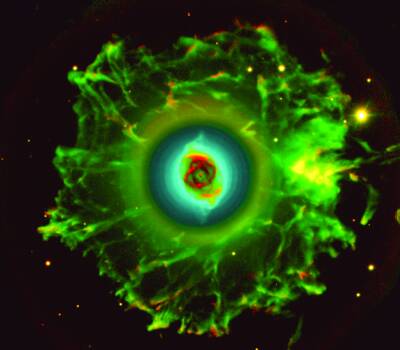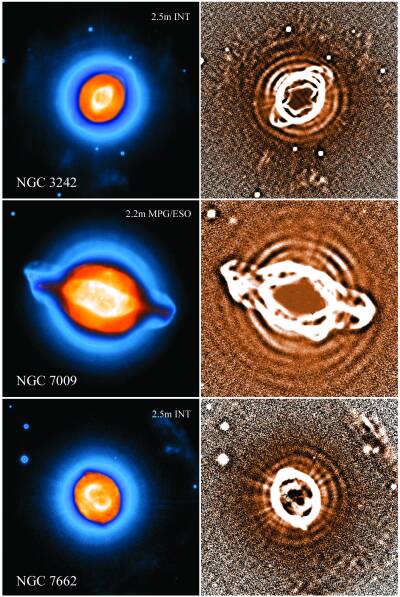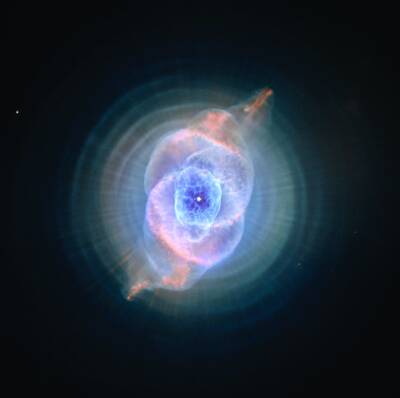The Bull’s Eye Pattern in the Cat’s Eye and
Other Planetary Nebulae
Romano L. M. Corradi
* (ING)
The
end-point of the evolution of solar-type stars is essentially determined
by the onset of a strong stellar wind, which, in a few hundred thousand years
completely removes the star’s gaseous envelope, thereby removing the fuel
that has previously maintained the thermonuclear energy source in its interior.
This phenomenon occur during a (second) phase in which the star becomes a
red giant, the so-called the Asymptotic Giant Branch (AGB) stage. In the
last million years of the AGB, the red giant is dynamically unstable and
pulsates with typical periods of few hundred days: a prototypical star in
this phase is Mira in Cetus. The mechanical energy of the pulsations pushes
large amounts of material far away enough from the core of the star for it
to cool down and condense into dust. This newly formed dust is further accelerated
out of the gravitational bounds of the star by the pressure of the radiation
coming from the hot stellar remnant. Gas, which is coupled to dust by collisions,
also leaves the star in this process.
In the last hundred thousand years of the AGB, this mass loss process is
so strong that the star is completely surrounded by a thick, expanding dust
shell that makes it very difficult to observe what is going on inside it.
One way to recover valuable information about this critical phase of stellar
evolution is to study the progeny of AGB stars, i.e. planetary nebulae (PNe).
These are nothing but the ejected AGB envelopes, heated by the radiation
of the hot stellar core, and therefore emitting at the specific wavelengths
(emission-lines) typical of the gas that they are composed of.
PNe are fantastic laboratories in which to study a variety of physical phenomena,
for example, in the past many aspects of atomic and molecular physics have
been addressed by studying PNe. More recently, PNe have become laboratories
for investigating the (hydro)dynamical formation of shock waves produced
by collisions between stellar winds, with the consequent formation of thin
gaseous shells, and bipolar flows or jets which closely resemble those observed
in other type of stars or in the nuclei of active galaxies. Now we know that
if we understand the formation of the complex and spectacular shapes displayed
by PNe, a lot can also be understood about the very late AGB evolution. A
few years ago, we have in fact shown that a large fraction of PNe, perhaps
the majority, are surrounded by large ionized haloes, one to ten thousand
times fainter that their inner regions (
Corradi
et al., 2003).
Figure 1 shows the halo of the
well-studied Cat’s Eye nebula (NGC 6543); other examples of PNe haloes can
be found in the
ING Newsletter No. 6, p. 35.
These haloes are the fossil remnants of the strongest mass loss phase during
the AGB, their edge corresponding to the last thermonuclear runaway (helium
shell flash) which occurred in a thin shell inside the stellar envelope before
the star left the AGB. These shell flashes are also called “thermal pulses”
and occur every 100,000 years for a solar-like star. In thermal pulse, mass
loss from the star is first significantly enhanced, and then quickly decreases.
Therefore mass loss during the AGB is modulated by the thermal pulses, the
last of which leaves an observable signature in the edge of the PNe haloes
(the gas loss during the previous thermal pulses has already diluted so much
that is hardly detectable).

|
| Figure 1. Image of the Cat’s Eye Nebula obtained
with the Nordic Optical Telescope at La Palma. Rings (displayed in blue in
order to better visualise them), are located in the inner regions of the
large filamentary halo of the nebula. [ JPEG
| TIFF ]
|
In 1999, HST images of the Cat’s Eye revealed the presence of a series of
shells in the inner regions of its halo (
Balick
et al., 2001). They appeared to be produced by mass ejected from the
star in a series of pulses at about 1500 years intervals during the last
20,000 years of the AGB evolution. Each shell contains about one hundredth
of the mass of the Sun, i.e. approximately the mass of all the planets in
the Solar System combined. When projected in the sky, these shells appear
as “rings” (or sometimes “arcs”) composing a sort of “bull’s-eye” pattern.
A new image of the Cat’s Eye, showing the full beauty of the rings, was recently
obtained with the ACS camera on the HST, and is displayed in
Figure 2.
Discovery of these rings came as a surprise, as mass-loss modulation on a
timescale of 1000 years was not predicted by theory (compare with the 100
times longer timescale of the recurrence of thermal pulses). First, it was
thought that rings were a rare phenomenon, but recent observations taken
with telescopes at ESO and La Palma, and mainly with the Wide Field Camera
of the 2.5 Isaac Newton Telescope, have instead shown that these structures
are likely the rule rather than the exception (
Corradi
et al., 2004). They are thus of general relevance to understanding the
large mass loss increase that characterises the end of the evolution of a
star like the Sun.
Figure 3, left, shows examples
of these rings in three PNe; these structures are better highlighted by appropriate
image processing (e.g. logarithmic derivatives or variations of this method,
as shown in
Figure 3, right).

|
| Figure 3. Images of rings recently detected in
PNe. Left: [OIII] images. Right: the same images processed to enhance the
rings (Corradi
et al., 2004, adapted from the A&A cover, April 2004 issue).
[ JPEG | TIFF ]
|
Several mechanisms have been proposed for the formation of these rings. They
include binary interaction (but the large detection rate weakens this hypothesis),
magnetic activity cycles, or stellar pulsations caused by instabilities in
the hydrogen burning shell inside the AGB envelope. Another possibility is
that gas is ejected smoothly from the star, and rings are created later on
due to formation of hydrodynamical waves in the outflowing material that
are caused by a complex coupling between gas and dust. This is an appealing
hypothesis, as it comes out naturally from our present knowledge of the physics
of the AGB mass loss. In any case, whatever the correct explanation, it is
clear that any AGB mass loss theory should now confront the evidence that
these rings are frequently found in PNe, and thus contain important information
relating to the very late evolution of a large fraction of stars in the Universe.
¤
References:
- Balick, B., et al., 2001, AJ, 121, 354. [ First citation in text | ADS
]
- Corradi, R., et al., 2003, MNRAS, 340, 417. [ First citation in text | ADS
]
- Corradi, R., et al., 2004, A&A, 417, 637. [
First citation in text | ADS
]
*Email contact: Romano Corradi (
rcorradi@ing.iac.es)





